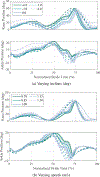Phase-Variable Control of a Powered Knee-Ankle Prosthesis over Continuously Varying Speeds and Inclines
- PMID: 35251752
- PMCID: PMC8890507
- DOI: 10.1109/iros51168.2021.9636180
Phase-Variable Control of a Powered Knee-Ankle Prosthesis over Continuously Varying Speeds and Inclines
Abstract
Most controllers for lower-limb robotic prostheses require individually tuned parameter sets for every combination of speed and incline that the device is designed for. Because ambulation occurs over a continuum of speeds and inclines, this design paradigm requires tuning of a potentially prohibitively large number of parameters. This limitation motivates an alternative control framework that enables walking over a range of speeds and inclines while requiring only a limited number of tunable parameters. In this work, we present the implementation of a continuously varying kinematic controller on a custom powered knee-ankle prosthesis. The controller uses a phase variable derived from the residual thigh angle, along with real-time estimates of ground inclination and walking speed, to compute the appropriate knee and ankle joint angles from a continuous model of able-bodied kinematic data. We modify an existing phase variable architecture to allow for changes in speeds and inclines, quantify the closed-loop accuracy of the speed and incline estimation algorithms for various references, and experimentally validate the controller by observing that it replicates kinematic trends seen in able-bodied gait as speed and incline vary.
Figures








References
-
- Voloshina AS and Collins SH, “Lower limb active prosthetic systems—overview,” in Wearable Robot, Rosen J and Ferguson PW, Eds. London, U.K.: Academic Press, 2020, pp. 469–486.
-
- Gailey R, Allen K, Castles J, Kucharik J, and Roeder M, “Review of secondary physical conditions associated with lower-limb amputation and long-term prosthesis use,” J. Rehabil. Res. Dev, vol. 45, no. 1, pp. 15–30, 2008. - PubMed
-
- Ehde DM, Smith DG, Czerniecki JM, Campbell KM, Malchow DM, and Robinson LR, “Back pain as a secondary disability in persons with lower limb amputations,” Arch. Phys. Med. Rehabil, vol. 82, no. 6, pp. 731–734, 2001. - PubMed
Grants and funding
LinkOut - more resources
Full Text Sources
